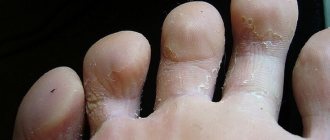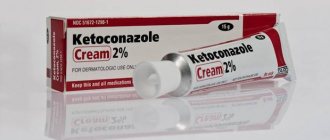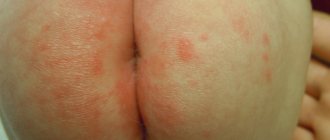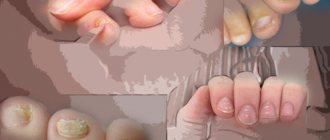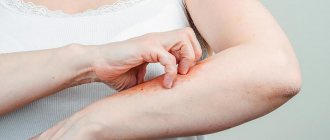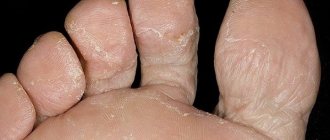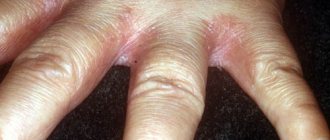In the modern world, few people pay proper attention to their own health. And it's actually very sad. Even the slightest deviations from the norm can lead to irreversible processes. Many people today complain of discomfort and disruption of the skin around the feet. Often this scourge also affects children. The skin on the legs may peel off in chunks. Why does this happen? What to do if the skin on your child’s feet peels off? Let's look at the main causes of this problem and ways to solve them.
What can cause it?
Why might a child's fingers peel off? There are a number of factors that provoke dryness and flaking, otherwise - desquamation of the skin on the legs.
Here are just some of the possible reasons:
- Lack of hydration of the epidermis. This can lead to dry skin. Peeling is often observed during the hot season. This is due to completely natural reasons: the body experiences a water shortage. Drying of the epidermis is often observed in winter. Skin moisture can be seriously reduced due to dry air in a room with heating devices.
- Wearing poor quality or uncomfortable shoes. Skin breathing is disrupted, which can lead to peeling and dryness.
- Skin may become peeling as a result of wearing synthetic socks or tights. The breathing process of the skin is disrupted, which negatively affects the condition of the feet. Synthetic materials cause peeling of the epidermis.
- Exposure to harmful fungi is one of the most common causes of flaky skin on the legs. Associated symptoms are severe itching and an unpleasant odor. Most often, those who have to visit public pools and baths encounter fungal diseases. When staying in such establishments, it is better to wear flip-flops or flip-flops.
- Lack of vitamins and minerals. This process occurs especially actively if it is accompanied by serious chronic diseases or weak immunity. Peeling of the skin in this case can be observed not only on the feet, but also on other parts of the body. These manifestations may also be accompanied by brittle nails and hair loss. Typically, peeling of the skin occurs in case of a lack of vitamins A and E. They are involved in the processes of skin regeneration.
- Chlorinated water: Long-term exposure to chlorinated and hard water can lead to peeling of the epidermis.
- Ultraviolet radiation: with prolonged exposure to the sun, cases of burns are often observed, which cause dryness and flaking of the skin.
- Poor nutrition and gastrointestinal dysfunction.
- Stress, overwork, overexertion.
Treatment of onychodystrophy in a child
Treatment of onychodystrophy in children consists of eliminating the root causes of its development and, if necessary, taking measures to correct altered nail plates.
To draw up his tactics, the podologist prescribes the child to perform dermatoscopy, microscopy of scrapings and, in some cases, mycological culture for differential diagnosis with onychomycosis. Consultations with related specialists may also be scheduled to determine the root cause of the deformity. To treat this pathology, it is recommended to eliminate factors that injure the nail (for example, wearing comfortable shoes, stopping toe sucking, treating a chronic disease). The treatment plan may include medications, physiotherapy, orthopedic and hardware correction techniques.
The Podology Clinic in Moscow is equipped with all the necessary expert-class equipment for the diagnosis and treatment of nail pathologies. The medical center performs all necessary types of physiotherapy, therapeutic hardware cleaning, laser therapy of nail plates. In difficult cases, a child or teenager undergoes nail prosthetics using high-quality artificial plates. All procedures are performed taking into account age characteristics.
Treatment of onychodystrophy with PinPointe laser
Doctors at the Podology Clinic are the only ones in Moscow who provide laser treatment for onychodystrophy in children using the innovative PinPointe device. Nail restoration begins from the first session! The procedures are absolutely painless and stimulate the growth of a healthy nail plate without removing the affected nail or taking medications. The high efficiency of laser therapy is explained by the unique ability of the device to deliver laser beams and uniformly heat the plate tissue to a temperature of 79°. At the same time, metabolic processes are stimulated, the trophism of the nail bed is restored and a healthy nail grows without complications or side processes.
Forecast
The Blade of Podology employs experienced and tactful doctors. The center has all the necessary equipment for high-quality and accurate diagnosis of the disease, including the PinPointe micropulse laser. During the treatment process, not only modern but also innovative methods are used to speed up the recovery of patients and guarantee excellent aesthetic results.
Prevention
In some cases, the following recommendations can prevent the development of onychodystrophy:
- exclusion of traumatic factors;
- balanced diet;
- timely correction of hypovitaminosis;
- elimination of excessive sweating of the feet;
- timely treatment of flat feet;
- compliance with personal hygiene rules;
- prevention and timely treatment of chronic diseases;
- refusal to use aggressive household chemicals and cosmetics;
- correct selection of products for the care of hands, feet and nails in accordance with age;
- preventing stress and increasing stress resistance.
Don’t let the disease take its course and don’t put off visiting a specialist! Remember that nails are an indicator of overall health! The specialists of the Podology Clinic will establish trusting contact even with the smallest patient and help him acquire healthy nails in the shortest possible time. Call the clinic or make an appointment with a podiatrist using the feedback form on the website - the doctors will select an effective treatment regimen for your child.
Description of the problem
What do you need to know about her? Why does the skin on my feet and toes peel? The skin on the heels is completely renewed in 3-4 weeks. This process is that the cells of the lower layer of the epidermis divide and move into the upper layers, which then fall off. If the regeneration process proceeds normally, the skin does not peel off. The epidermis on the heels is rougher, so often the process of cell renewal ends with the appearance of a dead layer. It quickly thickens, begins to peel and crack.
What to do if the skin on your child’s toes peels off? Treatment must include healing baths and the use of special creams. If you regularly carry out such procedures, your heels will remain smooth for a long time.
Treatment methods
Let's look at this in more detail. What should you do if your child has peeling skin on his feet? Once the problem is accurately diagnosed, the dermatologist can prescribe treatment. As a rule, in this case we are talking about complex therapy.
If there are signs of peeling, the following procedures may be prescribed:
- Foot baths with sea or table salt. You need to dilute one tablespoon of salt per liter of water. The exfoliated epidermis must be cleaned off using a special grater or pumice. Of course, for children's feet this procedure should be especially gentle. After performing this procedure, it is advisable to lubricate your feet with a special foot cream.
- A good remedy for peeling foot skin is laundry soap. Simply rub your feet with it and leave it until the morning, wearing socks made from natural materials. After feet, rinse with warm water and moisturize with cream.
- Taking vitamins A, B, E, D. A weakened body also requires selenium, zinc and magnesium.
- Proper diet. You need to add fruits, vegetables, sea oily fish and dairy products to your diet.
- If a doctor diagnoses a fungal infection, then to combat it it is necessary to use one of the following medicines: Lamisil, Exoderil, Microspor, Kanizon, Lotseril. These medications must be used strictly as prescribed by your doctor.
ethnoscience
Traditional treatment methods effectively help fight peeling and flaking of the skin of the feet, and also help cleanse it of dead cells. Using these recipes you can moisturize the skin of your feet and make your children healthy and all skin problems a thing of the past. Here are some effective recipes that will definitely help heal your tomboy’s legs:
- Take castor oil in the amount of one hundred milliliters and heat it using a water bath. If desired, it can be replaced with olive or flaxseed oil. Then mix warm butter with two yolks and beat thoroughly with a whisk. Treat the soles with the resulting mixture and wrap them in polyethylene, wearing woolen socks. Leave the compress on for forty minutes, then wash your feet in warm water using laundry soap.
- Take two hundred milliliters of chamomile decoction, mix it with three tablespoons of moisturizing cream and two tablespoons of starch. Stir until smooth. The resulting mixture must be applied to the soles every day, spreading over all surfaces. Wrap the resulting compress in plastic on top and leave it overnight. In the morning, wash your feet with water and apply moisturizer.
- Baths with the addition of decoctions of medicinal herbs will also be useful. For example, with string, nettle, chamomile and calendula. These plants have a beneficial effect on the skin and help get rid of flaking, dryness, flaking and itching of the lower extremities.
All of the folk recipes listed above can significantly improve the condition of the damaged epidermis and remove the unpleasant symptoms represented by itching, peeling and peeling.
Despite this, before being treated with folk remedies, be sure to show your child to a dermatologist, as he may be diagnosed with a serious disease in which these methods will be useless. Be healthy! Share:
Prevention measures
What do they include? If a child has peeling skin on his feet, there may be various reasons.
However, if you follow a few simple rules, you can easily get rid of this problem once and for all:
- Teach your baby to wash his feet every day before bed and lubricate them with moisturizer.
- Every other day, try to take warm foot baths with medicinal decoctions and infusions. Baths with soda or lemon juice have a good effect. The duration of the procedure should be at least 20 minutes. Softened and steamed feet must be processed, removing the lagging layer of epidermis.
- Choose your shoes carefully. Do not buy shoes that are too tight or narrow.
- Wear your child socks and tights made from natural materials (wool or cotton).
- Stay hydrated. Make sure your child drinks more water, especially during the hot season.
- Provide your child with proper nutrition. It’s not just that the skin on a child’s feet peels off. The reasons may lie in a poor diet. Make sure your food is rich in vitamins and minerals.
Avitaminosis
Why does the skin on my child’s feet peel off? The first and most obvious explanation is a lack of vitamins. This is especially common during the cold season. The skin begins to peel off on the face, arms and legs. These are obvious signs of a lack of vitamins A and E. This reason is one of the most harmless. After all, to deal with it, it’s enough to simply fill the vitamin deficiency. Enrich your child's diet with foods rich in vitamin A. These include tomatoes, carrots, parsley, green peas, and pumpkin. Also, for skin diseases, both children and adults need vitamin E, which is found in butter, cheese, barley and corn. The easiest way would be to take a course of special vitamin complexes.
You should not diagnose your child based on your own conclusions. Perhaps the reason why the skin on the baby’s feet peels off is completely different. Never self-medicate.
Allergy
An allergic reaction can occur to any internal or external irritant. The group of allergens includes:
- Food;
- clothing made from non-natural fiber;
- cosmetical tools;
- chemical substances.
As a result of the body's reaction to an irritant, an allergy appears, which is one of the types of skin disease called eczema. In a narrower concept, damage to the feet and hands is called dyshidrosis. At the initial stage of the disease, the skin may become blistered and then begin to peel off. Symptoms are also accompanied by itching. Over time, ulcers form and become crusty. In this case, you need to consult an allergist and dermatologist. After some tests and observations, an allergen is identified, with which contact must be completely stopped.
Impact of temperatures
During the cold season, the skin on the toes may peel off as a result of frostbite. After all, children often walk in the cold streets “until they are blue in the face.” They do not feel at all that their feet are wet and frozen. First of all, parents should assess the degree of frostbite. The child may need medical attention. Under no circumstances should you rub the affected areas with snow: there may be microcracks in the skin through which infection can enter the body. Try warming your baby's limbs in warm water, gradually increasing its temperature. With minor frostbite, the skin should turn pink and begin to tingle. To quickly restore the skin, experts recommend lubricating the affected area with Panthenol.
Peeling toes
The skin on your legs may peel off gradually. It usually starts with itching. At the same time, signs of destruction of the skin as such are not yet noticeable. The child may begin to scratch the skin. The areas of greatest concern are the areas between the toes. They may develop serious blisters that will later peel off. There are also cases where peeling of the skin on the fingers goes away without symptoms of itching. Nothing bothers the baby, and parents do not notice the problem. However, peeling clearly indicates the presence of some kind of functional disorder. If the disease is not treated promptly, the recovery process can be significantly delayed.
Dysbacteriosis
Any disturbances in the gastrointestinal tract are instantly reflected on the skin. This is especially true for infants, whose digestive system is not yet fully developed. Dysbacteriosis caused by an imbalance in the intestinal system can lead to immunodeficiency and allergies, which can also result from peeling skin in the area of the feet, hands and fingers. In this case, the child needs to take a course of probiotics and regularly eat foods enriched with lactic acid bacteria.
Fungus
Why does my child have peeling skin on his feet? The causes and treatment should be determined by a doctor. Often this symptom occurs due to a fungal infection. To avoid this problem, teach your child to follow the rules of personal hygiene. The child should not use other people's towels and shoes.
Treatment of foot fungus is a rather complex process that should be carried out under the supervision of a dermatologist. To determine the pathogen, it is necessary to undergo tests. If the skin peels off in winter, it is necessary to provide it with “breathing”. It is better if the baby walks barefoot or in slippers at home.
Complications
Lack of proper and timely treatment of onychohistorophy in children can lead to negative consequences:
- complete or partial destruction of the nail plate;
- addition of a fungal infection;
- paronychia;
- progression of the pathology causing onychodystrophy.
In addition to these complications, the unaesthetic appearance of the affected nail causes moral distress in the child. This defect can become a reason for unpleasant jokes and statements from peers, leading to the emergence of complexes and exclusion from society.
The development of complications of onychodystrophy can only be prevented by timely contact with a podiatrist.
